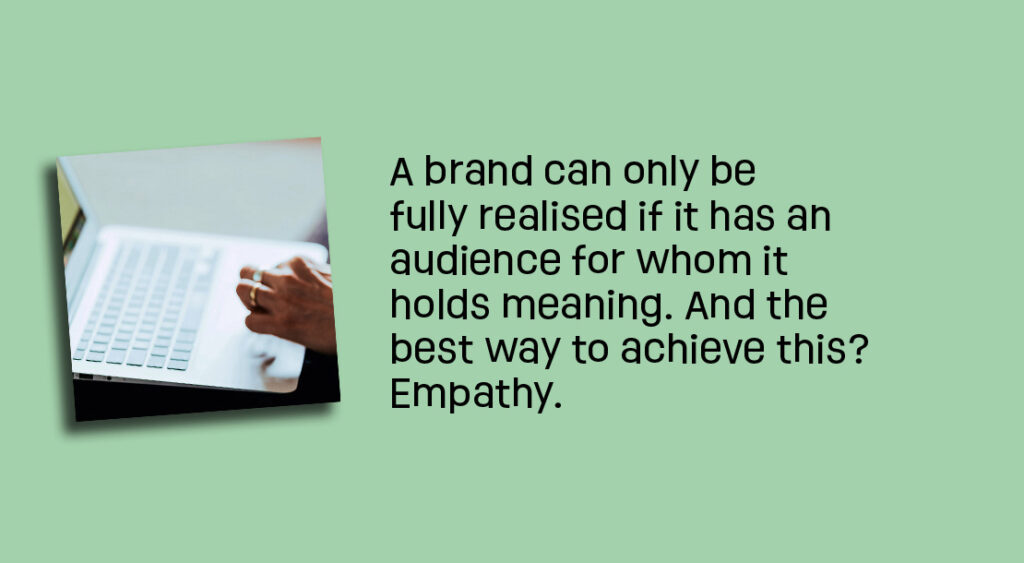When you use empathy in copywriting it builds trust, sparks emotional responses and helps drive decision-making.
Whether you’re marketing a product or service, you cannot assume that people will automatically want it. You’ve got to persuade them.
Prospects have pain points. If you can address these pain points, then you’ve a much better chance of persuading them that they should want your offering, or, even better, that they can’t live without it.
This is where empathy is highly effective. It’s how you show that you identify with your audience’s feelings. You share their pain.
Empathy is when you put yourself in someone else’s shoes – it’s the ability to understand their emotional state. People respond positively to displays of empathy. They feel recognised and visible.
It goes beyond pain points – empathy enables you to absorb and relate to other points of view and life experiences.

Show empathy and you’re positioning yourself as an ally, you earn your audience’s trust, and customers are more likely to buy from brands they trust.
Copywriting for brands comes down to a core principle: put the customer first.
This isn’t necessarily as straightforward as it sounds. Brands are like egos. They can get very caught up in themselves, obsessing over who they are and what they should be saying.
But a brand-first approach should be about the customer’s needs above all else. The brand’s personality and tone of voice should resonate with the customer. And the best way to achieve this? Empathy.
A brand can only be fully realised if it has an audience that accepts it and for whom it holds meaning. What makes a brand appear meaningful? Empathy.
It’s hardly revolutionary to suggest that the customer comes first, but in the increasingly sophisticated and competitive worlds of branding and marketing, this simple, powerful idea gets obscured or lost.
Ask yourself this question:
What is my audience really thinking and feeling?
Once you know the answer, you can begin to build an empathic (or empathetic) brand.
WARNING: Empathy isn’t as easy as you think.
There’s no I in empathy – to truly express empathy, you must take yourself out of the equation.
Simply stating a regard for your audience – “we know how you feel” – isn’t being empathic.
It’s a question of perspective. Your content should feel like it comes from your audience, putting them in the driving seat.
The Oxo family ads of the 1980s and 90s are perfect examples of an empathic approach.
Here, the family, complete with its minor dinner table skirmishes and archetypical characters, carries the message. We’re encouraged to observe them and identify with them.
But, then again, Oxo is a long-established consumer brand. Would this empathic approach work for B2B brands?
The answer’s YES, but only if:
B2B brands don’t do emotion. Despite the critical importance of emotion in decision-making, B2B brands prefer to stick to corporate language in their marketing communications.
But the decision-makers to whom these brands appeal are human beings. In this, they’re no different to consumers.
They’re looking to buy a product or service for their business, but this doesn’t stop emotion from being part of the process.
Think how many successful business deals depend on the chemistry between the separate parties involved.
In a face-to-face situation, you wouldn’t project a characterless stream of verbiage at another person and expect them to feel engaged by it. The same applies to your content.
Credibility doesn’t come with a large side-order of pomposity. Credibility is something you earn by demonstrating two things:
Far too many B2B brands focus almost exclusively on the latter.
This applies across various forms of content, from blogs, articles, case studies and whitepapers to direct response marketing such as emails and landing pages.
You can’t expect your audience to be blinded by the sheer brilliance of your expertise if you don’t also appeal to them on a human level that resonates with their feelings.
Here’s an example: the case study.
The commonplace approach is to begin with something along the lines of:
“We were commissioned by the client to improve their project management processes…”
The typical case study then outlines the issues, explains the methodology and states the outcomes. Essentially, it reads as a colourless, factual, step-by-step account.
True, it can contain metrics to support the case, but there’s precious little here to engage with the reader. It appeals to their head, not heart.
Why not? Why not begin a case study by focusing on how the client was feeling, why they needed help and what the consequences would be if they didn’t find the support and advice they needed?
Tell it like a story from the client’s viewpoint.
This way, the pay-off, when it comes, will be so much more impactful – how you helped the client and the positive outcome and legacy of this.
B2B brands that appeal to their audience’s feelings stand out from their competitors.
In a business landscape where so many of their contemporaries are hung up on how their peers perceive them, this could seem radical or even revolutionary.
But it’s not really. It’s logical to put your audience first. Empathise with them to win their trust.
You can use empathic content to grow your brand and business. Book an introductory chat with me and I’ll show you how.